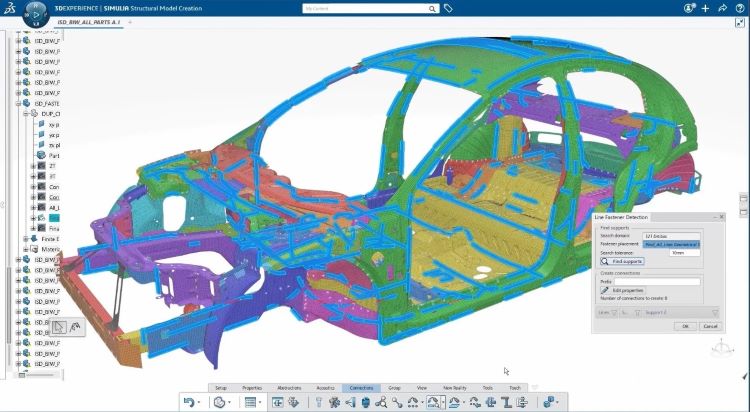Getting cars on the road takes more work than you might think. Beyond ideation and rounds of design and construction, vehicles must undergo significant safety testing before they’re road-ready.
While we’ve all seen videos with crash-dummy equipped cars driving into things, what goes on behind the scenes of these tests is a mystery to most. Understanding the capabilities, lifespan, and durability of components in various scenarios, being able to enhance and fine tune the inner workings of electronic systems within a car – there’s a seemingly never-ending checklist to finish.
With an eye toward safety and sustainability, Bertrandt, a global company headquartered in Germany, has for decades provided service-focused expertise for automotive and other industries. The company has a solution to minimize and streamline the wasteful, slow aspects of design, development and testing. Using Dassault Systèmes’ applications like SIMULIA, Bertrandt consolidates and streamlines the design, conception, manufacturing and testing processes, thereby empowering automotive companies to consider new, sustainable and safer ways to produce cars.
Dr. Holger Müller, Bertrandt’s Vice President of Operations, recently spoke with Laurence Montanari, VP of the Transportation and Mobility here at Dassault Systèmes about Bertrandt’s approach to prototype-less vehicle testing as part of our Executive Insights series.
Setting up for safety
Making cars safer doesn’t begin on a test course, but in a digital lab, with virtual simulation software being an important key to ensuring that cars are as safe as they possibly can be.
“Let’s use a normal car accident as an example,” says Müller. “Here, we must protect the occupants. To achieve this, the car body should have a large crumple zone to keep the stresses on the occupants low while also minimizing deformations in the survival space.
“We solve this conflict of objectives by optimizing the use of high-strength and flexible materials. And to find the optimum compromise in such a constellation, simulation-based development is the right tool for efficient implementation.”
Carrying out early-stage simulation testing can be a key indicator in ensuring a vehicle’s safety. “We use simulation to test different vehicle functions in [a] virtual environment,” Müller explains.
Vehicle components need to work predictably and in perfect harmony under a variety of conditions, and simulations enable manufacturers to see exactly how they’ll hold up. Driving can be unpredictable, but a car’s reaction to factors on the road or in its software shouldn’t be.

Spotlight on sustainability
When it comes to sustainability, Bertrandt’s approach works in a number of ways.
With virtual testing – as opposed to traditional physical testing – less waste is produced and designers can visualize how different materials will react and work in the long term. Being able to see, instead of simply attempting to predict, how materials will hold up or wear down, allows manufacturers to make informed decisions about the use of materials that will last and therefore be more sustainable. Considering factors like the lifetime of a component – including its ability to be recycled or broken down – helps companies make sustainability an achievable goal.
Simulation “allows us at an early stage in the concept development to check whether we [are achieving] the optimum in terms of price and ecological footprint,” Müller said. SIMULIA empowers Bertrandt to do exactly this, maintaining a commitment to both innovation and the environment simultaneously.
The element of innovation
Safety and sustainability aside, hardware-free testing for vehicles enables a faster rate of innovation. Quicker turnover for tests and optimizations make virtual simulation a breeding ground for new and revolutionary ideas. Fine-tuning and optimizations can also be done digitally, enabling fast and efficient changes to be made.
“The ability to simulate real-world scenarios and virtually test them helps OEMs (original equipment manufacturers) to quickly develop existing and new vehicle functions to a high level of maturity,” Müller said.
SIMULIA and the 3DEXPERIENCE platform empower companies like Bertrandt to venture into unconquered territories, to test the limits of convention, and to develop and design inventive solutions for the future. Bertrandt has already gone down this road with its connected autonomous driving vehicle HARRI, which won the German Innovation Award in 2020. The vehicle, an innovation platform in and of itself, represents how new and futuristic technologies can be combined with expertise from existing and storied industries to create fantastical concepts for tomorrow.
With simulation software accessible, there is seemingly endless potential for creating intelligent, innovative, safe and sustainable transportation possibilities.
Watch the full video of Montanari and Müller’s conversation.
For more information on SIMULIA and its use cases and, register for our upcoming 2023 EuroCentral Regional User Meeting from May 8-10 in Hanau, Germany and online.

